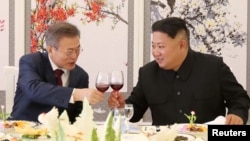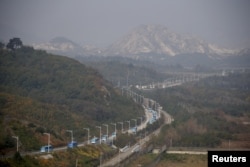Despite the sound bites and photos that emerged from the third summit between the leaders of South Korea and North Korea, peace and denuclearization remain distant, experts said.
“The video images of the hand-holding and hugging” gave “the impression that things are much farther along toward a peaceful settlement of disputes between North and South Korea than we know is in the reality,” Douglas Paal, vice president for studies at the Carnegie Endowment for International Peace, said of the meeting.
The three-day summit began Tuesday with thousands of North Koreans lining the streets of Pyongyang to welcome South Korean President Moon Jae-in on his first trip to North Korea.
It concluded with North Korean leader Kim Jong Un and Moon, and their wives, making a highly symbolic visit to Mount Baekdu, an active volcano near North Korea’s border with China that is the mythic birthplace of all Korean people, and the purported birthplace of Kim’s father.
Joint statement disappoints
The joint statement announced by the two leaders Wednesday, however, did not achieve the kind of concrete advance on denuclearization that North Korean watchers in Washington had hoped for after U.S.-North Korea relations appeared to hit a snag with the late August cancellation of a planned trip by U.S. Secretary of State Mike Pompeo to Pyongyang.
“[The summit] certainly improved the atmospherics on the peninsula in a way that I think is historic … and certainly unprecedented,” said Christopher Hill, a chief negotiator with North Korea during the George W. Bush administration.
The two Korean leaders agreed to transform the peninsula into a “land of peace without nuclear weapons and nuclear threats.” That prompted Pompeo to invite North Korean Foreign Minister Ri Yong Ho to meet in New York next week, where both are scheduled to attend the United Nations General Assembly.
“I don’t think, however, there’s a big change on the denuclearization,” Hill said.
Other experts said the joint declaration that the two leaders signed lacked substantive denuclearization agreements.
“I think it’s beneficial that [denuclearization] was raised as a topic,” Paal said. “But we’re not any closer to the steps toward real denuclearization as a result of this document so it should not be mistaken for progress.”
Paal added that absence of specific steps toward denuclearization “reflects (the) current status of the impasse between the sides on this issue.”
Kim sleight of hand
Although Kim agreed to dismantle the Tongchang-ri missile test facilities, also known as Sohae, under the observation of international inspectors, “for the first time … to witness the destruction. … It doesn’t mean very much because … you don’t need outside inspection to verify that these big facilities have been destroyed” given that satellites can track the process, according to Gary Samore, the White House coordinator for arms control and weapons of mass destruction during the Obama administration.
And because Kim had already agreed to partially destroy the Tongchang-ri site, which mainly was used to test engines built for long-range missiles such as the Hwasong-15, during the Singapore summit with President Donald Trump in June, “It’s selling the dead horse twice,” Paal said.
In the joint declaration, Kim also expressed his intent to dismantle the Yongbyon nuclear test site upon “corresponding measures” by the U.S. but “Yongbyon can easily be reactivated after being suspended, as we saw with its reactivation in 2003 after having been suspended since 1994,” said Sung-Yoon Lee, a professor of Korean studies at the Fletcher School of Law and Diplomacy at Tufts University. “It’s all a sleight of hand. Kim is the magician we are being conditioned to believe.”
General Jack Keane, a retired four-star Army general and former Army vice chief of staff said dismantling the Yongbyon facilities “is still not disarmament.” He added, “Without disarming nuclear weapons and their fuel … and destroying ballistic missiles … we have a long way to go.”
The kind of corresponding measures Kim is seeking most likely will involve “the question of the [South Korea]-U.S. alliance,” Hill said.
What Pyongyang wants
North Korea could ask for measures such as a peace declaration, which both Koreas want as a way to end the Korean War that was suspended in 1953 with an armistice rather than a peace treaty, said Michael Fuchs, deputy assistant secretary of state for Eastern Asia and Pacific affairs during the Obama administration.
Pyongyang is also likely to reiterate its demand for the withdrawal of U.S. troops from the peninsula, Paal said. North Korea has repeatedly said that the U.S. military presence in South Korea poses a threat to its regime. Currently, there are about 28,500 U.S. troops stationed in South Korea.
Bruce Klingner, a onetime intelligence officer specializing in Korean affairs who is a senior research fellow at the Heritage Foundation, said evidence points to the contrary.
“When North Korea says it needs evidence that the U.S. and South Korea don’t have a hostile policy, well, which Korea invaded the other in 1950? Which Korea has committed countless acts of terror, war, threatened and killed [citizens of] the other Korea?” Klingner said.
“It’s always North Korea that’s done the heinous acts, so it’s the U.S. and Seoul which should be demanding actions first from North Korea, not only to fulfill the requirements under the 11 U.N. resolutions, but also to prove North Korea doesn’t have any more hostile intent.”
Keane said the U.S. will maintain its military presence until North Korea removes its complete stockpile of nuclear weapons and missiles.
“We are not going to fall into that trap,” Keane said. “The United States sees that for what it is, and we are not certainly removing any troops from South Korea until such time as [there are] no nuclear weapons and no ballistic missiles in the North.”
Inter-Korea projects
At the summit, Moon agreed with Kim to start construction of a railroad to connect the countries, and resume operations at the Kaesong Industrial Complex and tours on Mount Kumgang. The ventures have the potential to violate international sanctions imposed on North Korea.
“So here, President Moon is making a lot of promises he can’t fulfill without the U.N. or the U.S. backing off on enforcement of U.N. sanctions and U.S. law,” Klingner said. “Many, particularly in Seoul, are advocating relief or release from sanctions. But all of the U.N. and U.S. sanctions and targeted financial measures are a response to North Korean illegal or aberrant behavior.”
The agreement to reduce tensions along the North Korean and South Korean division of demilitarized zone (DMZ) is real progress, however.
“The most tangible progress here in terms of improving the situation on the Korean Peninsula is the … multiple-page military agreement that was signed by both sides that … outlines a significant number of steps to try to reduce … military tensions at the DMZ, which I think is a good step,” Fuchs said.
At the summit, South Korean Minister of National Defense Song Young-moo and First Vice Minister of People’s Armed Forces of North Korea No Kwang Chul signed a comprehensive military agreement to halt military exercises along the military demarcation line by Nov. 1 and remove 11 guard posts in the DMZ by year’s end.
Keane said the plan to have “the two armies from South and North pull away from each other,” is a good sign as they will no longer be “deployed inside their respective countries to go to war and return to their bases and just doing their routine training.”
However, he added, “I think that we could have to see all of that before we would consider reducing our troop’s level.”
VOA's Christy Lee contributed to this report.












